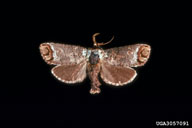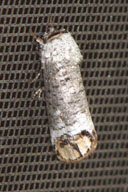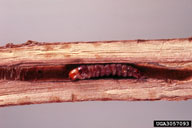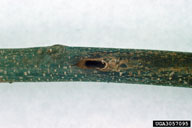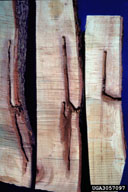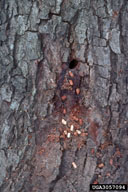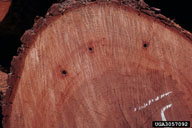Pecan carpenterworm
Cossula magnifica (Stecker) (Lepidoptera: Cossidae)
Orientation to pest
Pecan carpenterworm, Cossula magnifica (Stecker), is a native wood boring moth that occurs throughout the southeastern United States, where it reproduces in pecan (Carya illinoinensis [Wangenh.] K. Koch), oak (Quercus), and hickory (Carya). Adults emerge in spring and lay their eggs on bark of small twigs. Young larvae bore in the pith of twigs. Larger larvae move into the branches or the trunk, where they excavate tunnels several inches in length. Frass is expelled through the larval tunnel, which is kept open and enlarged as the larva grows. Pupation occurs in the larval tunnel in the spring. There is one generation per year.
Hosts commonly attacked
This borer attacks pecan (C. illinoinensis), oak (Quercus), and hickory (Carya).
Distribution
This borer occurs in the southeastern United States.
Images of pecan carpenterworm
| Figure 1. Adult of pecan carpenterworm, Cossula magnifica; right, in natural pose | Figure 2. Larva of pecan carpenterworm | Figure 3. Entrance of pecan carpenterworm tunnel in twig | |
| Figure 4. Larval tunnels of pecan carpenterworm seen in longitudinal section in pieces of milled wood | Figure 5. Frass pellets and staining below the tunnel opening of the pecan carpenterworm | Figure 6. Larval tunnels of pecan carpenterworm seen in cross section in a log |
Important biological control agents related to this pest species
Two tachinid parasitoids - Phorocera comstocki Williston and Phorocera signata Aldrich and Webber - have been reared from this species, but not much is known of their effects on the insect's population dynamics.
